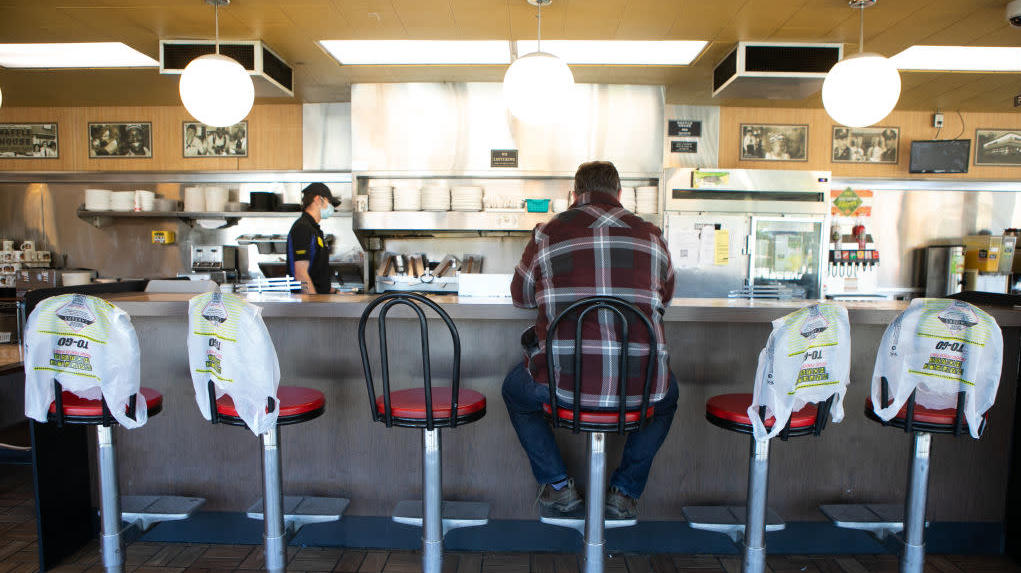How Restaurants Got Clever To Weather The Pandemic
We all know that our own cooking and eating habits have changed over the past year in light of a situation we never thought we'd find ourselves in. And as much as our own patterns have been altered, the businesses that feed us have had to make adjustments to weather the storm, too—we know the word "pivot" has been used ad nauseam in this context, but that actually makes it sound more seamless and effortless for these businesses to pull off than it really was. For both large chains and independently owned restaurants, it involved hard work, quick and clever thinking, appeals to the community, and of course, some measure of luck. Nation's Restaurant News has compiled a slideshow of the solutions that the industry found to continue operating during an unforeseen pandemic, and some of the trends are worth highlighting here.
Restaurants started selling more than just their menu offerings
All the way back in May 2020, chef and restaurant owner Phillip Foss predicted, "It's possible that restaurants won't just be 'a place that serves food.' They will become a distribution channel." This prediction appears to have been accurate; NRN notes that once restaurants were unable to host guests in their dining rooms, they instead began selling groceries, paper goods, and meal kits to fulfill the need they saw in their communities. (Even Subway got in on it.) It was a great way for restaurants to offload excess inventory in the absence of a dinner rush, but also a natural opportunity to partner with other local businesses. It's likely that even after indoor dining returns to full capacity, we'll see restaurants continue those partnerships.
Food was designed with delivery in mind
This country went wild for chicken wings in 2020, for a number of reasons—but one huge benefit wings have over other foods is how well they travel relative to other delivery options. When delivery and takeout became the main focus for a majority of restaurants, menu offerings were retooled (or built from the ground up) with delivery in mind. Explains NRN, "Some [businesses], like Panera Bread, even revamped new menu items inspired by a new need for durable deliverables, like the bakery chain's flatbread pizzas, that were rolled out in October 2020 with a thicker crust so that they will stay crispy even after they've traveled to a customer's house." And it's a matter of packaging, too: as we saw with KFC's new chicken sandwich, heat-retaining pouches can keep food from going cold in transit, too.
Restaurants themselves got a makeover, too
"With the rise of modernized drive-thru lanes and shrinking of dining rooms," NRN explains, "many brands have announced store revamps and redesigns to keep up with changing consumer demands." These changes were likely in the works well before COVID-19, but the rise in mobile ordering and on-the-go pickup is a natural fit for a post-pandemic landscape, too, when people might feel more skittish about sitting down to eat in high-traffic fast casual dining rooms. But not every chain is taking the shrunken-down mobile-order kiosk approach to its redesign. Some chains, like Sonic, are opting for outdoor community gathering space.
Menus are now on our phones
I truly thought QR codes were on their way out with the 2010s, a relic of an in-between technological era when smartphones proliferated but apps hadn't yet become the norm. How wrong I was! QR codes are quickly becoming the standard for restaurant menus, allowing customers to download the menu and peruse it from their phone rather than touch a paper menu. Many have called out surface transmission concerns as unfounded, and the constant disinfecting of tables and menus "hygiene theater," but that hasn't stopped restaurants from embracing this new (old) technology. Beyond allaying diners' fears, digital menus are presumably easier to make alterations to, rather than reprinting menus whenever items are no longer available.
The NRN list contains a lot more trends, such as increased use of AI in restaurant kitchens and more "family pack" style menu offerings, but suffice it to say that 2020 established a new normal, and for restaurants, it'll probably be one that lasts beyond the pandemic. For the full list, head here.
